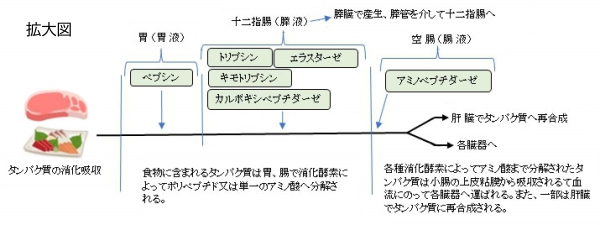
・「末端からジペプチドを順次遊離する場合はジペプチジルアミノペプチダーゼとよばれる.」(栄養・生化学辞典)
・「蛋白質,ペプチドのアミノ酸鎖をN 末端から段階的に加水分解し,アミノ酸を生じる反応を触媒する酵素。」(ブリタニカ国際大百科事典)
・「末端からジペプチドを順次遊離する場合はジペプチジルアミノペプチダーゼとよばれる.」(栄養・生化学辞典)

以下は「Wikipedia」の解説文となる。
Aminopeptidases are enzymes that catalyze the cleavage of amino acids from the amino terminus (N-terminus) of proteins or peptides (exopeptidases). They are widely distributed throughout the animal and plant kingdoms and are found in many subcellular organelles, in cytosol, and as membrane components. Aminopeptidases are used in essential cellular functions. Many, but not all, of these peptidases are zinc metalloenzymes.
【語句】
・catalyze:触媒作用を及ぼす ・cleavage:分割 ・terminus:末端 ・subcellular:細胞内の ・organelle:小器官 ・cytosol:細胞基質 ・zinc metalloenzymes:亜鉛金属酵素
Some aminopeptidases are monomeric, and others are assemblies of relatively high mass (50 kDa) subunits. cDNA sequences are available for several aminopeptidases and a crystal structure of the open state of human endoplasmic reticulum Aminopeptidase 1 ERAP1 is presented here. Amino acid sequences determined directly or deduced from cDNAs indicate some amino acid sequence homologies in organisms as diverse as Escherichia coli and mammals, particularly in catalytically important residues or in residues involved in metal ion binding.
One important aminopeptidase is a zinc-dependent enzyme produced and secreted by glands of the small intestine. It helps the enzymatic digestion of proteins. Additional digestive enzymes produced by these glands include dipeptidases, maltase, sucrase, lactase, and enterokinase.
【語句】
・monomeric:単量体の ・assembly:集合 ・cDNA:相補DNA ・sequence:配列 ・: ・crystal structure:結晶構造 ・endoplasmic reticulum:小胞体 ・deduce:推測する ・homology:相同関係 ・diverse:種々の、多様な ・Escherichia coli:大腸菌 ・catalytically:触媒として ・residue:残余 ・metal ion binding:金属イオン結合 ・zinc-dependent enzyme:亜鉛依存性酵素?
